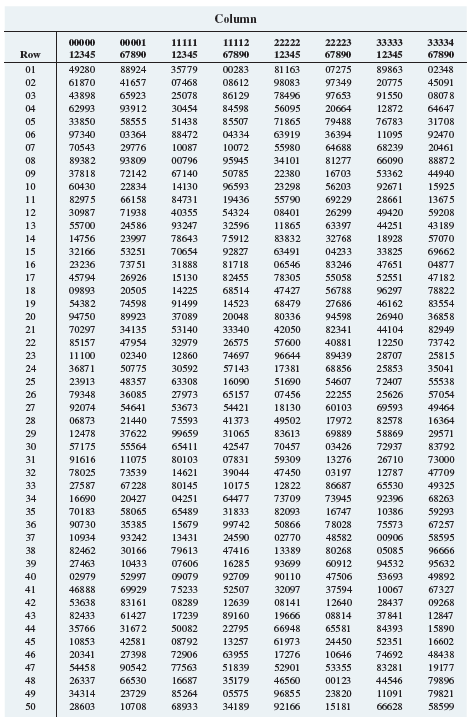Question: Use the table of random numbers (Table E.1) to simulate the selection of different-colored balls from an urn, as follows: a. Start in the row
Use the table of random numbers (Table E.1) to simulate the selection of different-colored balls from an urn, as follows:
a. Start in the row corresponding to the day of the month in which you were born plus the last two digits of the year in which you were born. For example, if you were born October 3, 1990, you would start in row 93 (3 + 90). If your total exceeds 100, subtract 100 from the total.
b. Select two-digit random numbers.
c. If you select a random number from 00 to 94, consider the ball to be white; if the random number is from 95 to 99, consider the ball to be red.
Each student is to select 100 two-digit random numbers and report the number of “red balls” in the sample. Construct a control chart for the proportion of red balls. What conclusions can you draw about the system of selecting red balls? Are all the students part of the system? Is anyone outside the system? If so, what explanation can you give for someone who has too many red balls? If a bonus were paid to the top 10% of the students (the 10% with the fewest red balls), what effect would that have on the rest of the students? Discuss.
Table E.1
Column 00000 00001 11111 11112 22222 22223 33333 33334 Row 12345 67890 12345 67890 12345 67890 12345 67890 01 88924 00283 02348 49280 35779 81 163 07275 89863 61870 41657 98083 97349 45091 02 07468 08612 86129 20775 03 43898 65923 25078 78496 97653 91550 0807 8 20664 04 62993 93912 30454 84598 56095 12872 64647 85507 05 33850 58555 51438 71865 79488 76783 31708 63919 55980 03364 88472 04334 06 97340 36394 11095 92470 10072 07 70543 29776 10087 64688 68239 20461 95945 08 89382 93809 00796 34101 81277 66090 88872 72142 50785 16703 09 37818 67140 22380 53362 44940 10 60430 22834 14130 96593 23298 56203 92671 15925 13675 11 82975 66158 84731 19436 55790 69229 28661 12 30987 71938 40355 54324 08401 26299 49420 59208 55700 24586 93247 32596 11865 63397 44251 43 189 14 14756 23997 78643 75912 83832 32768 18928 57070 69662 32166 53251 70654 92827 63491 04233 33825 16 23236 73751 31888 81718 06546 83246 47651 04877 78305 55058 47182 17 45794 26926 15130 82455 52551 09893 20505 14225 68514 47427 56788 96297 78822 14523 54382 74598 91499 68479 27686 46162 83554 94750 89923 37089 20 20048 80336 94598 26940 36858 33340 42050 44104 21 70297 34135 53140 82341 82949 22 85157 47954 32979 26575 57600 40881 12250 73742 11 100 02340 12860 74697 96644 89439 28707 25815 57143 25853 24 36871 50775 30592 17381 68856 35041 63308 16090 23913 48357 51690 54607 72407 55538 26 79348 36085 27973 65157 07456 22255 25626 57054 92074 18130 27 54641 53673 54421 60103 69593 49464 06873 21440 75593 41373 49502 17972 82578 16364 37622 12478 99659 31065 42547 83613 69889 58869 29571 57175 55564 65411 70457 03426 72937 83792 13276 91616 11075 80103 07831 59309 26710 73000 47709 78025 73539 14621 39044 47450 03197 12787 67 228 12822 27587 80145 10175 86687 65530 49325 16690 20427 04251 64477 73709 73945 92396 68263 58065 65489 10386 70183 31833 82093 16747 59293 99742 90730 35385 15679 50866 78028 75573 67257 13431 10934 93242 24590 02770 48582 00906 58595 79613 96666 82462 30166 47416 13389 80268 05085 07606 93699 27463 10433 16285 60912 94532 95632 40 02979 52997 09079 92709 90110 47506 53693 49892 52507 41 46888 69929 75233 32097 37594 10067 67327 53638 42 83161 08289 12639 08141 12640 28437 09268 82433 12847 61427 17239 89160 19666 08814 37 841 22795 15890 44 35766 31672 50082 66948 65581 84393 61973 17276 10853 08792 42581 13257 24450 52351 16602 46 20341 27398 72906 63955 10646 74692 48438 90542 51839 53355 47 54458 77563 52901 83281 19177 79896 26337 66530 16687 35179 46560 00123 44546 34314 23729 96855 238 20 85264 05575 11091 79821 28603 58599 10708 68933 34189 92166 15181 66628
Step by Step Solution
3.49 Rating (166 Votes )
There are 3 Steps involved in it
Results will vary due to individual differences in classes The proposed class project is a variat... View full answer

Get step-by-step solutions from verified subject matter experts


